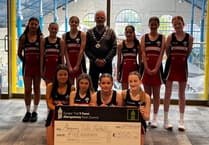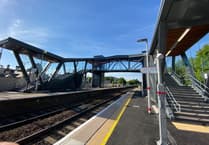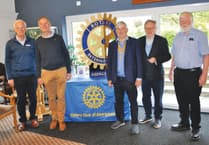IN this first of a series looking at the streets of Abergavenny we reveal the fascinating history of Frogmore Street.
THE pedestrianisation of Frogmore Street is almost complete, and as one of Abergavenny’s most popular thoroughfares enters a new chapter in its colourful history, let’s rewind the clock, take a stroll down memory lane and unearth just a few of the hidden treasures buried in what was once little more than a damp marshland.
It’s been written that Frogmore street gets its name due to the fact that it used to be home to a soaring population of frogs.
How much truth there is in that little wife’s tale, we’ll never know, but what we do know with a cast iron certainty is in days of old, when knights were bold and maidens wore chastity belts, Frogmore Street didn’t exist.
Yet once upon a time, there was a tollgate on the Brecon Road, situated where chapel Road and Commercial Street meet and this was called the Frogmore Street Gate. And where HSBC now stands was the site of the medieval North Gate.
It’s safe to say old Abergavenny was something of a gated community back then.
Cox’s map of 1800 shows Frogmore Street occupied on both sides by a continuous line of houses broken only by Lion Street and White Horse Lane, which was then nameless.
Unlike New York, where the streets have no name, and not half as much history, Frogmore Street contains at least several buildings which are nearly 500 years old. Yet the earliest record of a tradesman operating out of Aber’s old West End as it’s sometimes known was one David Morgan - an 18th-century potter.
Bailey Park gate-makers
By the time of the roaring twenties, the 1820s that is, James Daniel’s London Hat and Shoe Warehouse was doing a brisk trade, as was John Lewis and Sons. The iron-founders who operated out of Frogmore Street and had a foundry in Lewis Lane, ( a street named after this illustrious family and originally called Lewis Court), made both the railings which surround Hyde Park and the Bailey Park Gates.
Simon Andrews was also another ironmonger who worked in Frogmore Street and was one of the Abergavenny jurors at the trial of the famous Chartist, John Frost.
A stock-in-trade for the Frogmore Street ironmongers was the room bells, which they sold to many an Abergavenny gent and lady who hung them in their homes and used them to summon their overworked and underpaid servants.
In Victorian times Frogmore street was a dream of diversity. Banks, pubs, churches, chapels, smithies, stables, and shops selling an exotic flavor of wares, all rubbed shoulders together in a ramshackle celebration of life.
It even had two plush mansions to call its own. One of these was where Barclays Bank now stands and once belonged to wealthy sporting attorney and Sheriff, Robert Morgan Kinsey.
It was later occupied by his brother, General William Kinsey, who was the grandfather of the surgeon Elmes Yelverton Steel.
Steel and his son were both medical men and would become two of Abergavenny’s most well-known and popular citizens.
Dovers the printers was another well-known Abergavenny business that could be reached, via the passage, which still exists, at the upper end of Frogmore Street.
Dovers was originally built during the early 19th century as the Catholic chapel of St Michael. The chapel replaced two earlier ones built on land given to the Franciscans by one Peter Morgan in 1687.
The chapel of St Michael was later purchased by Cross Street’s notorious Catholic recusant,Thomas Gunter.
In the wake of his death, the property was returned to the Franciscans by his wife. It ceased to function in 1869 when the church of Our Lady and St Michael’s opened in Pen-y-Pound.
Where Ladbrokes now stands, used to be the old Abergavenny Chronicle office. The proprietor was Edwin Morgan(pictured), printer, bookbinder, bookseller, stationer, and newsagent whose specialty in the 1870s was “Pictures framed in Gold, Gilt, and every description of fancy wood on the shortest notice and lowest price.”
The Chronicle later moved from number 16 Frogmore Street to number 26 in 1962. The building is now owned by Tesco’s, but just prior to 1962 it was a Co-op.
H Shakleton Ltd is still a familiar face in the town. The well-loved Abergavenny business began life in 61 Frogmore Street in Spring 1873.
But as the 20th century thundered on, like no century before or since, many other Frogmore businesses such as the wheelwrights, the saddlers and harness makers, the clockmakers, the cabinet makers and the sculptors had closed their doors for good as a new era of mass production, which had little time or regard for artisan offerings, was ushered in on the winds of change.
A street full of pubs
Pubs! Don’t you just love them! They certainly did it Abergavenny back in the day. The old town was heaving with watering holes for a weary soul to rest their legs and quench their thirst and Frogmore Street was no exception.
The Golden Lion, which Lion Street was named after, was the oldest recorded pub in Abergavenny before its closure. Standing at number six Frogmore Street,
It was to the Golden Lion that Father David Lewis, the Abergavenny born martyr, was brought for examination after his capture at Lantarnam. shortly after he was hanged at Usk on August 27, 1679.
The Golden Lion’s landlord, William Crump, sat on the jury at the trial of Chartist leader John Frost
The Golden Lion was later known as the Sugarloaf but it called last orders in 1986. You’ll know it today as Cafe Nero.
The King David, which once stood on the corner of Lewis Lane was also noted for its home-brewed beer and its stables could accommodate 20 horses.
The Britannia, which still stands, can be traced back to at least the reign of William IV. It was not always a corner premise and existed before the cutting of Baker Street.
The White Horse Inn (pictured below) (no. 14), which was demolished in 1965 achieved some notoriety in 1825 as the starting point of a ‘feat of pedestrinization’. The handbill from that time reads as follows.
“Pedestrian J. Townsend most respectfully informs the inhabitants of Abergavenny and Monmouth that on Monday morning, July 11, 1825, he will start from the White Horse, Abergavenny, and walk to the Robin Hood, Monmouth, and return to the White Horse, and go to the Lamb and Flag, Llanwenarth, and return to the White Horse - being a distance of 66 miles in one day.
“This feat he will perform for six successive days. No man ever performed such as an astonishing feat before. It is for no wager, but merely to show the people of Abergavenny and Monmouth what he can do. Any donations that they may be pleased to give will be thankfully received.”
Abergavenny body-snatchers
An ostler at the white horse called ‘Jack o ‘Breed’ was said to have been quite the character. He caused an even bigger stir upon his death.
Apparently, after he was buried in St Mary’s Church Yard, some young men in the town, several of whom belonged to the medical profession, dug his body up for the purpose of dissection.
Poor old Jack had, through the years, sold his body to the doctors over and over again for a trifling consideration.
The good doctors were merely claiming what they thought was the end product of a fair and just bargain. The subsequent hue and cry in the town about the theft of Jack’s body caused the ‘resurrectionists’ to reflect on their actions and the body was placed back in the coffin.
The Butchers’ Arms which used to stand opposite the War Memorial was one of the town’s oldest houses and was thought to have been Elizabethan.
And that’s just the tip of the iceberg when it comes to the many pubs which could once be found in Frogmore Street. You also had the King William (no 7), the Old Herefordshire House (no 25), the Butcher’s Arms (no 42), the George Inn (no 43), the Three Salmons (no 46), The Bell (no 50), The Griffin Inn (no 59), The Welcome Temperance Hotel (no 60), and The Black Swan, to name but a few.
So next time you take a goosey gander down Frogmore Street,(and after its recent refurbishment there’s never been a better time!) take a moment to pause, reflect, and look around. There’s a lot of history to be found there and a lot of history still to be made. It was here long before we were born, and hopefully, with our continued support, of its shops, cafes, pubs, bus, eateries, and businesses, it’ll be here for our children’s children to wander around and marvel at that which came before and continues to flourish.
If you’ve got any old pictures or stories about the Streets of Abergavenny, then get in touch and contact Tim Butters on 01873 852187 (30), or email him on [email protected].





Comments
This article has no comments yet. Be the first to leave a comment.